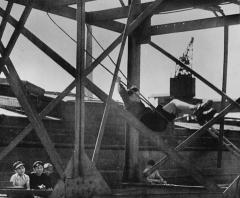After last year’s great reception of Isidore Isou’s film “Venom and Eternity” (1951), Romanian Cultural Centre in London (RCC) has the pleasure to present the work of Eli Lotar, another less known Romanian born avant-garde artist. To introduce him to our audience and illustrate his contribution to art history, we selected two documentaries: “Aubervilliers” (1946), directed by himself, and Henri Storck's “The Houses of Misery” (Les Maisons de la misère) (1937) where Lotar worked as cameraman.
The films are fine examples of subversive and radical social documentaries drawing upon the aesthetic traditions of negation, critique and provocation. Artists like Lotar and Storck used montage, collage and appropriation to produce radical artistic interventions which echoed in the social reality of those troubled times. The ripples of those echoes still topical nowadays.
Eli Lotar (Eliazar Lotar Theodoresco, 1905–1969) can be easily placed among the most important artists of the 20th century. From his beginnings in photography, in the 1920s, as assistant of Germaine Krull, Eli Lotar was particularly interested in industrial architecture and the life of the working class, in accordance with a political commitment clearly marked on the left. With his “Slaughterhouses of La Villette” series, published in George Bataille’s journal “Documents” in 1929, Lotar became an iconic figure of the visual surrealist movement, yet one often unfairly marginalised in the history of art.
Although known for his photography, Lotar also worked as a cameraman on numerous cinematographic projects with filmmakers such as René Clair, Luis Buñuel, Jacques Brunius, Joris Ivens, Jean Painlevé, and Jean Renoir. He was renowned for his amazing technical prowess, using the camera as a discovering agent, ferreting out the essence of a scene.
Eli Lotar (1905 – 1969)
Eliazar Lotar Teodorescu was born in Paris (he was the illegitimate son of the Romanian writer Tudor Arghezi and Constanta Zissu), but grew up in Bucharest. In 1924 he returned to Paris, becoming a French citizen in 1926. In the same year he met the German photographer Germaine Krull and became her assistant and partner. From 1929 to 1932 he had shared a group photo studio with Jacques-André Boiffard. In 1938, Lotar married Estonian Jewish Billancourt Elisabeth Makovski. During the Nazi occupation of France, they both fled to La Roquette-sur-Siagne (Alpes-Maritimes). After the war, Lotar neglected his work. He died in Paris on May 10, 1969, during a dinner with his friend Philippe Guérin.
Eli Lotar - The Lost Son of The Avant-garde
Romanian Cultural Centre in London, 18 Fitzhardinge Str, Manchester Square

Ad
Event has ended
This event ended on Wednesday 16th of September 2015
This event ended on Wednesday 16th of September 2015
Admission
free
free
Location
Romanian Cultural Centre in London, 18 Fitzhardinge Str, Manchester Square
Tags:
Film
User Reviews
There are no user reviews
